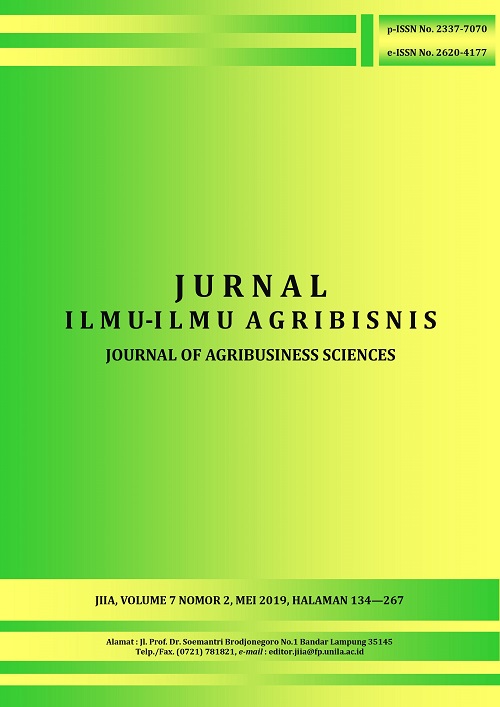KAJIAN SOSIAL EKONOMI DAN TINGKAT KESEJAHTERAAN RUMAH TANGGA PETANI KELAPA SAWIT DI KABUPATEN TULANG BAWANG
DOI:
https://doi.org/10.23960/jiia.v7i2.3381 Abstract View: 929
Abstract View: 929
Abstract
This study aims to determine the social, economic and welfare level of oil palm farmer households in Tulang Bawang Regency. The study was conducted in August 2017. The research sample was 54 farmers who are divided into two categories, namely 46 farmers of narrow land and 8 farmers of wide land. The data is analyzed by qualitative description. The level of well-being is measured by socio-metric indicators. The results of the study showed that the average farmer respondents in the study area either of narrow land or wide land had good social categories conditions. Income earned by farmers from oil palm farming of narrow land was Rp29,941,900 / year with a contribution of 83.87% and of labor was 3.91% from the available 329 men working day/year. Farmers of the wide area had earned Rp86,165,100/year from oil palm farming with a contribution of 94.65% and of labor was 19.82% of the 329 men working day/year. The level of welfare showed that both of narrow land and large land were in the category of not poor.
Key words: economic conditions, oil palm, social conditions, welfare
Downloads
Downloads
Published
How to Cite
Issue
Section
License
Authors who publish with this journal agree to the following terms:
Authors retain copyright and grant the journal right of first publication with the work simultaneously licensed under a Creative Commons Attribution License that allows others to share the work with an acknowledgement of the work's authorship and initial publication in this journal.
Authors are able to enter into separate, additional contractual arrangements for the non-exclusive distribution of the journal's published version of the work (e.g., post it to an institutional repository or publish it in a book), with an acknowledgement of its initial publication in this journal.
Authors are permitted and encouraged to post their work online (e.g., in institutional repositories or on their website) prior to and during the submission process, as it can lead to productive exchanges, as well as earlier and greater citation of published work (See The Effect of Open Access).














